Seungwoo Yoo
Neural Pose Representation Learning for Generating and Transferring Non-Rigid Object Poses
Jun 14, 2024



Abstract:We propose a novel method for learning representations of poses for 3D deformable objects, which specializes in 1) disentangling pose information from the object's identity, 2) facilitating the learning of pose variations, and 3) transferring pose information to other object identities. Based on these properties, our method enables the generation of 3D deformable objects with diversity in both identities and poses, using variations of a single object. It does not require explicit shape parameterization such as skeletons or joints, point-level or shape-level correspondence supervision, or variations of the target object for pose transfer. To achieve pose disentanglement, compactness for generative models, and transferability, we first design the pose extractor to represent the pose as a keypoint-based hybrid representation and the pose applier to learn an implicit deformation field. To better distill pose information from the object's geometry, we propose the implicit pose applier to output an intrinsic mesh property, the face Jacobian. Once the extracted pose information is transferred to the target object, the pose applier is fine-tuned in a self-supervised manner to better describe the target object's shapes with pose variations. The extracted poses are also used to train a cascaded diffusion model to enable the generation of novel poses. Our experiments with the DeformThings4D and Human datasets demonstrate state-of-the-art performance in pose transfer and the ability to generate diverse deformed shapes with various objects and poses.
As-Plausible-As-Possible: Plausibility-Aware Mesh Deformation Using 2D Diffusion Priors
Nov 28, 2023Abstract:We present As-Plausible-as-Possible (APAP) mesh deformation technique that leverages 2D diffusion priors to preserve the plausibility of a mesh under user-controlled deformation. Our framework uses per-face Jacobians to represent mesh deformations, where mesh vertex coordinates are computed via a differentiable Poisson Solve. The deformed mesh is rendered, and the resulting 2D image is used in the Score Distillation Sampling (SDS) process, which enables extracting meaningful plausibility priors from a pretrained 2D diffusion model. To better preserve the identity of the edited mesh, we fine-tune our 2D diffusion model with LoRA. Gradients extracted by SDS and a user-prescribed handle displacement are then backpropagated to the per-face Jacobians, and we use iterative gradient descent to compute the final deformation that balances between the user edit and the output plausibility. We evaluate our method with 2D and 3D meshes and demonstrate qualitative and quantitative improvements when using plausibility priors over geometry-preservation or distortion-minimization priors used by previous techniques.
SALAD: Part-Level Latent Diffusion for 3D Shape Generation and Manipulation
Mar 21, 2023Abstract:We present a cascaded diffusion model based on a part-level implicit 3D representation. Our model achieves state-of-the-art generation quality and also enables part-level shape editing and manipulation without any additional training in conditional setup. Diffusion models have demonstrated impressive capabilities in data generation as well as zero-shot completion and editing via a guided reverse process. Recent research on 3D diffusion models has focused on improving their generation capabilities with various data representations, while the absence of structural information has limited their capability in completion and editing tasks. We thus propose our novel diffusion model using a part-level implicit representation. To effectively learn diffusion with high-dimensional embedding vectors of parts, we propose a cascaded framework, learning diffusion first on a low-dimensional subspace encoding extrinsic parameters of parts and then on the other high-dimensional subspace encoding intrinsic attributes. In the experiments, we demonstrate the outperformance of our method compared with the previous ones both in generation and part-level completion and manipulation tasks.
Online Extrinsic Camera Calibration for Temporally Consistent IPM Using Lane Boundary Observations with a Lane Width Prior
Aug 09, 2020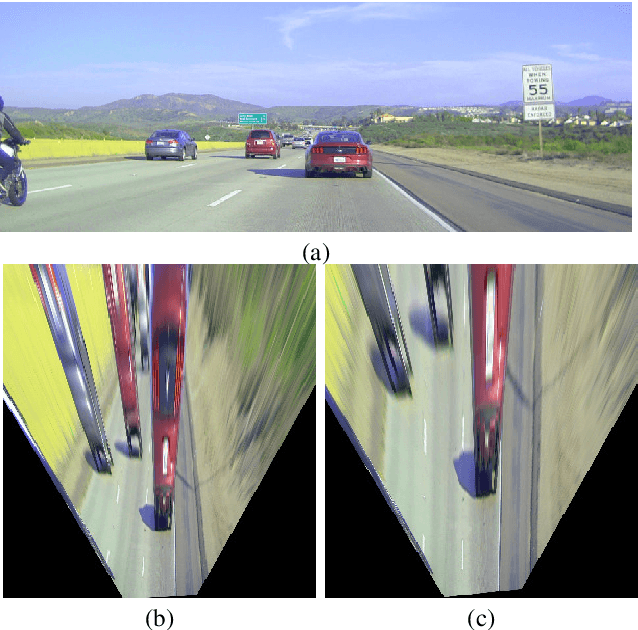
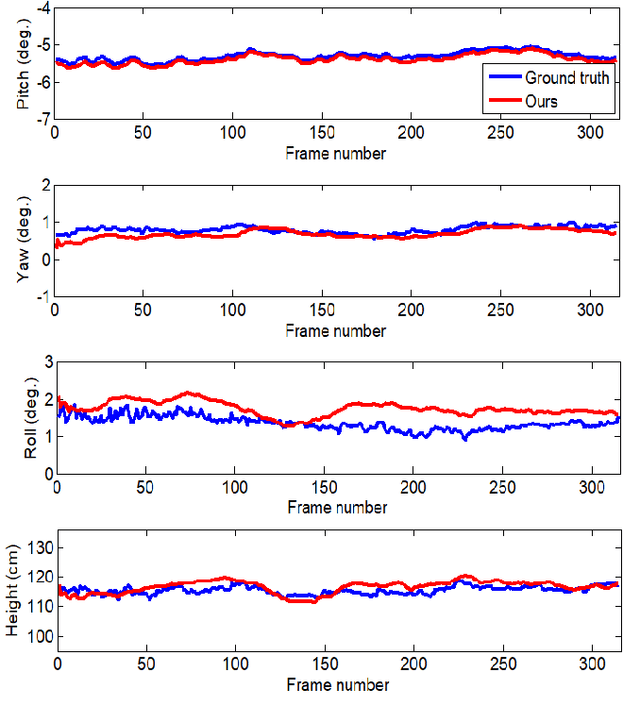

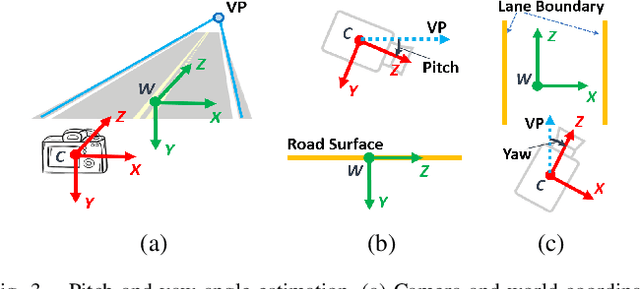
Abstract:In this paper, we propose a method for online extrinsic camera calibration, i.e., estimating pitch, yaw, roll angles and camera height from road surface in sequential driving scene images. The proposed method estimates the extrinsic camera parameters in two steps: 1) pitch and yaw angles are estimated simultaneously using a vanishing point computed from a set of lane boundary observations, and then 2) roll angle and camera height are computed by minimizing difference between lane width observations and a lane width prior. The extrinsic camera parameters are sequentially updated using extended Kalman filtering (EKF) and are finally used to generate a temporally consistent bird-eye-view (BEV) image by inverse perspective mapping (IPM). We demonstrate the superiority of the proposed method in synthetic and real-world datasets.
End-to-End Lane Marker Detection via Row-wise Classification
May 06, 2020
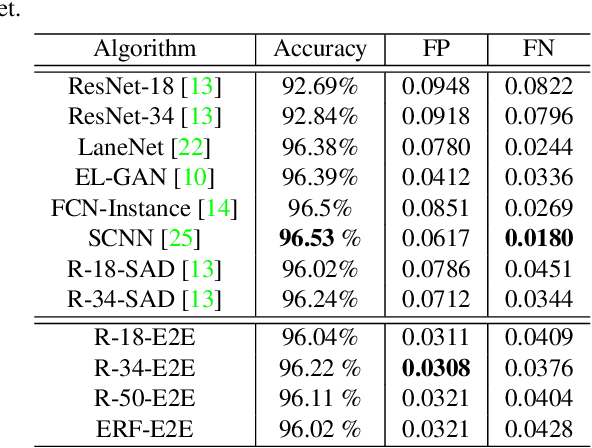
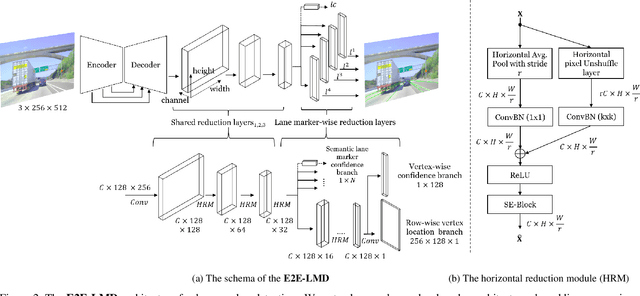
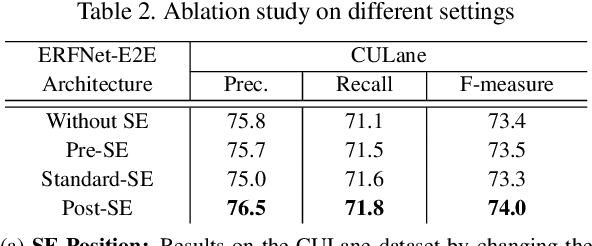
Abstract:In autonomous driving, detecting reliable and accurate lane marker positions is a crucial yet challenging task. The conventional approaches for the lane marker detection problem perform a pixel-level dense prediction task followed by sophisticated post-processing that is inevitable since lane markers are typically represented by a collection of line segments without thickness. In this paper, we propose a method performing direct lane marker vertex prediction in an end-to-end manner, i.e., without any post-processing step that is required in the pixel-level dense prediction task. Specifically, we translate the lane marker detection problem into a row-wise classification task, which takes advantage of the innate shape of lane markers but, surprisingly, has not been explored well. In order to compactly extract sufficient information about lane markers which spread from the left to the right in an image, we devise a novel layer, which is utilized to successively compress horizontal components so enables an end-to-end lane marker detection system where the final lane marker positions are simply obtained via argmax operations in testing time. Experimental results demonstrate the effectiveness of the proposed method, which is on par or outperforms the state-of-the-art methods on two popular lane marker detection benchmarks, i.e., TuSimple and CULane.
 Add to Chrome
Add to Chrome Add to Firefox
Add to Firefox Add to Edge
Add to Edge